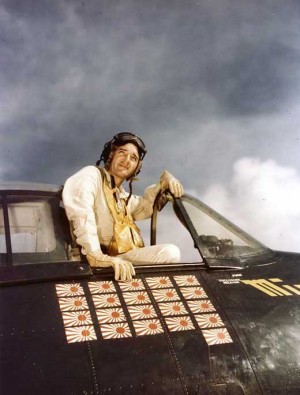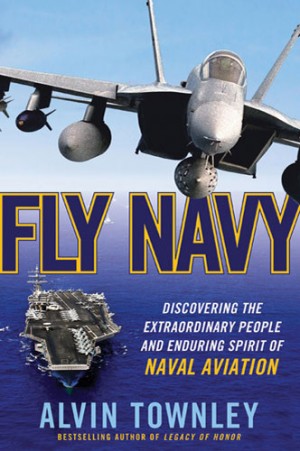By Alvin Townley
In a dogfight, expect anything. All bets are off.
 Nobody drove that lesson home more pointedly than David McCampbell, a son of Bessemer, Alabama, who downed more enemy aircraft than any other naval aviator—ever. By the end of World War II, he’d destroyed thirty-four enemy planes in the type of thick, guns-only, air-to-air dogfights Hoser would have given his other thumb to join.
Nobody drove that lesson home more pointedly than David McCampbell, a son of Bessemer, Alabama, who downed more enemy aircraft than any other naval aviator—ever. By the end of World War II, he’d destroyed thirty-four enemy planes in the type of thick, guns-only, air-to-air dogfights Hoser would have given his other thumb to join.
“Dashing Dave” McCampbell’s career had started inconspicuously. He graduated the U.S. Naval Academy in 1933, and was discharged into the reserves that same day; the navy had limited its officer commissions. He spent a disappointing year working construction and assembling airplanes in Bessemer before the navy recalled him and he finally earned his wings at Pensacola in 1938. He made his real debut six years later.
When he first tasted aerial combat on May 19, 1944, he was serving as CAG, commander of soon- to-be-legendary Air Group Fifteen, aboard the aircraft carrier USS Essex. He didn’t down any bogies but his F6F Hellcat, named Monsoon Maiden, returned from the day’s mission so shredded by enemy bullets that the flight deck crew finished the job the Japanese had started by pushing the propeller-driven Grumman fighter into the sea. McCampbell would go on to fly in Minsi, Minsi II, and finally Minsi III, which finished the war with thirty-four small Japanese flags neatly painted under its canopy, signifying its pilot’s victories.
Flying Minsi II exactly one month after his first combat flight, the thirty-four-year- old commander became an ace. The title required five confirmed kills and most aces achieved their designation after numerous missions. McCampbell earned it in a single day: June 19, 1944. That morning saw the beginning of a two-day carrier duel that was the largest to date, with more than 1,300 aircraft involved on both sides. The Americans embarked 905 of those aircraft aboard their fifteen flattops. Yet in the day’s second raid, the Japanese far outnumbered the Americans. An inbound flight of 109 Japanese Jill torpedo bombers, Judy dive bombers, and Zeke (or Zero) fighters was met by Dashing Dave and only ten other Fighter Squadron Fifteen (VF-15) Hellcats. Undeterred by the numbers, the eleven American fighters pushed over and set upon their quarry.
For six minutes, these Essex fighters defended their floating home until forty-three other Hellcats joined the fray. McCampbell made good use of his time. While the remainder of his group handled the Zekes overhead, Dave raked the formation of Judys from one side then the other, alternating approaches until he’d downed five. With his ammunition spent, he returned to Essex as the newly arrived Hellcats devoured the remainder of the Japanese strike.
When a fourth wave of Japanese planes attempted to attack the American fleet late that day, McCampbell and VF-15 were airborne again, this time over Guam. Dave quickly downed one Zeke for kill number six. Another maneuvered onto his tail and he radioed for help. He raced toward a rendezvous point where three of his squadron mates took care of the trailing Zeke.
He passed along the favor by doing the same for another Hellcat. That was his seventh kill of the day. At breakfast that morning, he’d had only two to his name.
Dave’s fellow Air Group Fifteen aviators destroyed sixty-one additional planes that day, far more than any other air group, and the legend of the Fabled Fifteen was born. The fleet’s other carrier air groups chipped in to claim a total of 388 Japanese planes shot down in air-to-air combat (although the real number was likely closer to 275). American combat losses on June 19 were seventeen F6F fighters and eight other aircraft.
While history officially refers to the action as the Battle of the Philippine Sea, the pilots always called it the Marianas Turkey Shoot. And nobody shot more than the air group commander from Alabama. But he wasn’t finished. The Fabled Fifteen’s leader had one more coup before the air group’s seven-month tour de force ended; by the tour’s end, they would sink more tonnage and shoot down more enemy aircraft than any other carrier air group in history.
On October 24, 1944, McCampbell had his greatest day. It began when he and his wingman ambushed a flight of some forty Japanese Zeke and Oscar fighters. The fighters were returning to Manila from a mission when McCampbell’s group spied them. The ace watched them from on high until they formed into a tight formation. “That’s when we went to work on them,” McCampbell recalled.
McCampbell and his wingman, Roy Rushing, began ravaging the formation from above, with many of their diving attacks yielding two downed Japanese aircraft apiece. By the time his fuel and ammunition ran low, McCampbell had shot nine planes out of the sky for a single-day record that remains unsurpassed. When he returned to the carrier, his tanks and magazines were virtually empty. “When I tried to [taxi forward after landing], I gave [the throttle] near full gun, and the engine conked out on me. So I ran out of gas on the deck. They had to push me out of the landing area. I found out from the mech who reammunitioned the guns that I had exactly six rounds left in the starboard outboard gun, and they were all jammed. But it worked out all right. For his actions that October day, Commander Mc Campbell received the Medal of Honor from President Franklin Roosevelt.

Excerpted from Fly Navy: Discovering the Extraordinary People and Enduring Spirit of Naval Aviation by Alvin Townley.
Reprinted with permission of the publisher.
All rights reserved. This work is protected under copyright laws and reproduction is strictly prohibited. Permission to reproduce the material in any manner or medium must be secured from the Publisher.
ALVIN TOWNLEY spent four years traveling around the world to capture stories of leadership, service, and adventure. He has met with inspiring leaders from all walks of life who are pursuing adventures with a higher purpose – from young naval aviators, Peace Corps volunteers, and Olympic athletes to seasoned CEOs, admirals, and Cabinet members.
In 2007, St. Martin’s Press released his acclaimed first book, Legacy of Honor. Spirit of Adventure followed in 2009, and Fly Navy followed in 2011, during naval aviation’s centennial celebration.
To write his books, Alvin discussed life and leadership with leaders like Defense Secretary Robert Gates, Supreme Court Justice Stephen Breyer, Hank Paulson, Michael Bloomberg, J.W. Marriott, Jr., Bill Gates, Sr., JanSport founder Skip Yowell, and Jim Lovell of Apollo 13. He also dove Australia’s Great Barrier Reef with a marine biologist, cruised the Pacific, Atlantic, and Indian Oceans aboard four aircraft carriers, ventured into Africa with the Peace Corps and went into our own inner-cities with Teach for America.
Alvin grew up in Atlanta, Georgia, where he earned the rank of Eagle Scout with Troop 103. He was a brotherhood member of the Order of the Arrow, and found a life-long love for adventure at Philmont Scout Ranch, the Northern Tier Canoe Base, the Florida Sea Base, and countless other wilderness spots.
Alvin graduated from Washington & Lee University in Lexington, Virginia, and has worked in the U.S. House of Representatives, helped manage global strategy for a $9B international consulting firm, and coached track and field. To write his first book, he sold his house and quit his job and began an odyssey that continues today as he tells America’s great stories and champions the values of Scouting and the military. He lives in his hometown of Atlanta, Georgia, and has shared his message of leadership, values, and “adventure with purpose” with thousands of people in more than thirty states.
